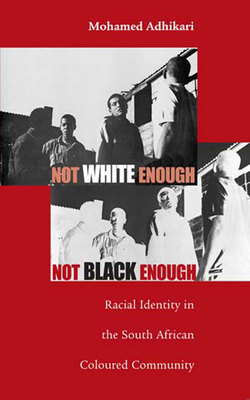Not White Enough, Not Black Enough

Реклама. ООО «ЛитРес», ИНН: 7719571260.
Оглавление
Mohamed Adhikari. Not White Enough, Not Black Enough
Отрывок из книги
Not White Enough, Not Black Enough
Executive editor: Gillian Berchowitz
.....
What is more, those cultural features commonly accepted as distinctively Coloured have generally been denigrated and accorded low status in South African society. The Afrikaans vernacular distinctive to the Coloured community and variously referred to as Capey, Gamtaal (language of Ham), or kombuis (kitchen) Afrikaans has, for example, customarily been stigmatized as a mark of social inferiority. Until relatively recently, before the argument for Afrikaans being a creole language gained popularity, there was widespread acceptance within the Coloured community of white and especially Afrikaner denigration of kombuis Afrikaans as a vulgar patois. By way of example, a middleclass Coloured informant in the mid-1990s told me that although kombuis Afrikaans was his home language, he felt ashamed of using it when speaking to whites or “respectable people,” as it would mark him as “low class.”55 An Afrikaner school inspector in the mid-1970s exemplified white attitudes toward the dialect when, on hearing me speak the vernacular to some of my high school students, he admonished me, in a gentle but paternalistic tone, for using “daardie gebasterde taal” (that bastardized language) and perpetuating uncultured practices among my students.56 The Coon Carnival, a celebration of the new year particular to the Coloured community—though embraced by most working-class Coloured people as their own and more recently touted as an example of colorful Cape culture to promote tourism—was similarly stigmatized among whites and middle-class Coloureds as boorish, disreputable, and even depraved.57
The lack of positive identification with Colouredness meant that much of the social mobilization and political activity conducted in the name of the Coloured people was in reaction to white racism rather than a proactive marshaling of ethnic resources. Throughout the era of white domination, anger, anxiety, and fear engendered by the social injustices they suffered rather than a positive identification with Colouredness proved to be the more potent means for mobilizing people on the basis of their identity as Coloured. Coping with white racism rather than affirming Colouredness motivated a great deal of these separatist agendas. Virtually all Coloured communal organizations, whether cultural, professional, or political, either were formed because Coloured people were excluded from the corresponding white bodies or were established in response to one or another segregationist development. Coloured responses to segregationism, which, with the exception of the radical movement, generally sought to protect Coloureds’ position of relative privilege, thus tended to reinforce existing racial boundaries despite the nonracial rhetoric that usually accompanied them. The pervasiveness of racial identifications was such that even in the most obvious exception to this pattern, the Non-European Unity Movement, the outcome of fifteen years of endeavor was a split largely along racial lines in 1958.58
.....